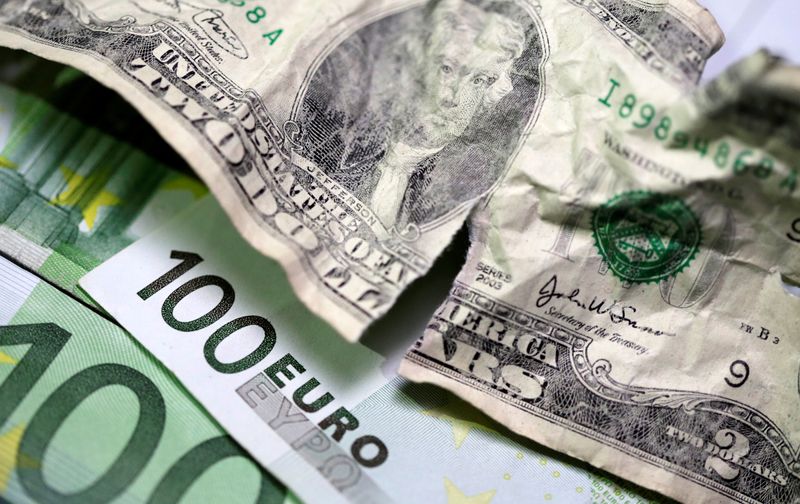 © Reuters. FILE PHOTO: U.S. dollar and Euro banknotes are seen in this picture illustration taken May 3, 2018. REUTERS/Dado Ruvic/Illustration
© Reuters. FILE PHOTO: U.S. dollar and Euro banknotes are seen in this picture illustration taken May 3, 2018. REUTERS/Dado Ruvic/Illustration
By Gertrude Chavez-Dreyfuss
NEW YORK (Reuters) - The U.S. dollar advanced from two-week lows on Friday after data showed the world's largest economy created far more jobs than expected, raising the chances of a larger Federal Reserve interest rate increase at the March policy meeting.
The dollar index, a gauge of its value against six major currencies, rose 0.1% to 95.446, after falling to a two-week low of 95.136 earlier amid a resurgent euro.
But the dollar was still down 1.8% on the week, on pace for its largest weekly percentage decline since November 2020.
Data showed U.S. nonfarm payrolls grew 467,000 jobs last month. Data for December was revised higher to show 510,000 jobs created instead of the previously reported 199,000.
Economists polled by Reuters had forecast 150,000 jobs added in January. Estimates ranged from a decrease of 400,000 to a gain of 385,000 jobs.
Market participants were prepared for a weaker-than-forecast reading given the decline in the ADP U.S. private payrolls report released earlier this week. That report showed a decline due to the impact of the Omicron coronavirus variant.
Average hourly earnings, a measure of wage inflation and a closely-watched metric, also rose 0.7% last month, and 5.7% on a year-on-year basis.
"It is the 0.7% month-on-month gain in wages that is most hawkish," wrote Daragh Maher, head of FX strategy, at HSBC. "This helps counter dollar-bearish real income squeeze concerns and the stagflation theme, and will likely energize FOMC (Federal Open Market Committee) hawks.
The dollar also tracked the surge in U.S. Treasury yields.
U.S. two-year and five-year yields, both of which reflect interest rate expectations, rose to 1.2970%, the highest since late February 2020, and 1.79%, its best level since July 2019, respectively.
In the afternoon session, U.S. rate futures implied more than five rate hikes this year, or about 134.4 basis points in policy tightening. The probability of a 50 basis-point increase next month rose to nearly 40%, from just 18% before the data release.
The euro was still up on the day, rising 0.1% at $1.1455. It was up 1.7% on the week, on track for its best weekly performance since late March 2020, benefiting from a hawkish turn by the European Central Bank (ECB) on Thursday.
The euro stalled around the resistance level of $1.1480 because of dollar gains following the U.S. employment report.
HSBC's Maher said the euro/dollar pair is likely to resume its upward momentum given that the market seems more fixated on the ECB's hawkishness, which surprised markets, than the Fed.Sterling also has been among the big currency movers this week, after the Bank of England raised rates to 0.5% on Thursday - marking the first back-to-back increases by the central bank since 2004. The pound though fell 0.5% to $1.3536. On the week, it was up 1% this week.
========================================================
Currency bid prices at 3:38PM (2038 GMT)
Description RIC Last U.S. Close Pct Change YTD Pct High Bid Low Bid
Previous Change
Session
Dollar index 95.4040 95.3620 +0.06% -0.271% +95.7040 +95.1360
Euro/Dollar $1.1457 $1.1439 +0.17% +0.79% +$1.1483 +$1.1411
Dollar/Yen 115.1900 114.9950 +0.18% +0.07% +115.4200 +114.7700
Euro/Yen 131.96 131.53 +0.33% +1.26% +132.0900 +131.4600
Dollar/Swiss 0.9249 0.9200 +0.54% +1.40% +0.9258 +0.9195
Sterling/Dollar $1.3534 $1.3599 -0.47% +0.08% +$1.3614 +$1.3505
Dollar/Canadian 1.2746 1.2677 +0.55% +0.81% +1.2788 +1.2663
Aussie/Dollar $0.7080 $0.7140 -0.83% -2.59% +$0.7151 +$0.7052
Euro/Swiss 1.0597 1.0522 +0.71% +2.20% +1.0602 +1.0522
Euro/Sterling 0.8465 0.8412 +0.63% +0.77% +0.8469 +0.8406
NZ $0.6616 $0.6664 -0.71% -3.32% +$0.6683 +$0.6590
Dollar/Dollar
Dollar/Norway 8.7730 8.7205 +0.69% -0.33% +8.8160 +8.6995
Euro/Norway 10.0554 9.9494 +1.07% +0.42% +10.0787 +9.9603
Dollar/Sweden 9.1362 9.0863 +0.68% +1.31% +9.1718 +9.0641
Euro/Sweden 10.4711 10.4007 +0.68% +2.32% +10.4855 +10.3900

